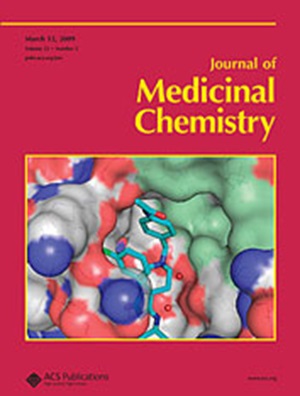Development of [99mTc]TcO-ABX474: Design, Synthesis, and Biological Evaluation of PSMA-Binding Technetium-99m Radioligands for SPECT Imaging of Prostate Cancer
IF 6.8
1区 医学
Q1 CHEMISTRY, MEDICINAL
引用次数: 0
Abstract
A current global limitation to the timely and equitable patient access to PSMA-based therapies for prostate cancer (PCa) is the insufficient PET capacity for pretreatment imaging. However, the extensive global availability of SPECT cameras renders this imaging technology as an attractive alternative. The lack of regulatory approved PSMA radioligands for SPECT imaging of PCa prompted us to design new 99mTc-labeled radioligands with a fast pharmacokinetic profile by harnessing proven complexation of the [99mTc][TcO]3+ core by a bis(aminoethanethiol) chelator. Six 99mTc-labeled PSMA radioligands were synthesized and biologically characterized in cell-based assays and by SPECT imaging in LNCaP tumor-bearing mice. From this series, [99mTc]TcO-5 ([99mTc]TcO-ABX474, Kd(PSMA) = 6.1 ± 1.7 nM) displayed the most advantageous properties for SPECT imaging of PCa: high and fast tumor uptake accompanied by rapid clearance from nontarget tissues, leading to faster pharmacokinetics than observed for the reference [99mTc]Tc-PSMA-I&S. Furthermore, [99mTc]TcO-5 performed similar to the established PSMA–PET radioligand [68Ga]Ga-PSMA-11.

求助全文
约1分钟内获得全文
求助全文
来源期刊

Journal of Medicinal Chemistry
医学-医药化学
CiteScore
4.00
自引率
11.00%
发文量
804
审稿时长
1.9 months
期刊介绍:
The Journal of Medicinal Chemistry is a prestigious biweekly peer-reviewed publication that focuses on the multifaceted field of medicinal chemistry. Since its inception in 1959 as the Journal of Medicinal and Pharmaceutical Chemistry, it has evolved to become a cornerstone in the dissemination of research findings related to the design, synthesis, and development of therapeutic agents.
The Journal of Medicinal Chemistry is recognized for its significant impact in the scientific community, as evidenced by its 2022 impact factor of 7.3. This metric reflects the journal's influence and the importance of its content in shaping the future of drug discovery and development. The journal serves as a vital resource for chemists, pharmacologists, and other researchers interested in the molecular mechanisms of drug action and the optimization of therapeutic compounds.
 求助内容:
求助内容: 应助结果提醒方式:
应助结果提醒方式:


